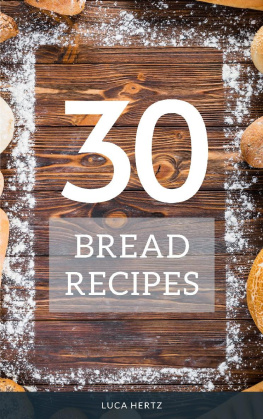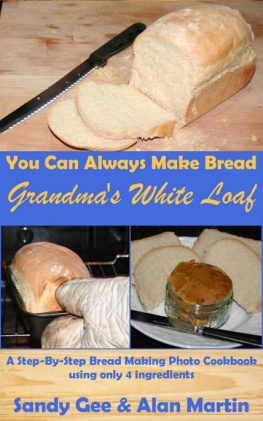Vegan Bread Cookbook:
simple, inexpensive, yummy the most popular bread baking recipes
Copyright 2020 - All rights reserved.
The contents of this book may not be reproduced, duplicated or transmitted without direct written permission from the author.
Under no circumstances will any legal responsibility or blame be held against the publisher for any reparation, damages, or monetary loss due to the information herein, either directly or indirectly.
Legal Notice:
This book is copyright protected. This is only for personal use. You cannot amend, distribute, sell, use, quote or paraphrase any part or the content within this book without the consent of the author.
Disclaimer Notice:
Please note the information contained within this document is for educational and entertainment purposes only. Every attempt has been made to provide accurate, up to date and reliable complete information. No warranties of any kind are expressed or implied. Readers acknowledge that the author is not engaging in the rendering of legal, financial, medical or professional advice. The content of this book has been derived from various sources. Please consult a licensed professional before attempting any techniques outlined in this book.
By reading this document, the reader agrees that under no circumstances is the author responsible for any losses, direct or indirect, which are incurred as a result of the use of information contained within this document, including, but not limited to, errors, omissions, or inaccuracies.
Table of Contents
Introduction
Who doesn't love the smell of freshly baked bread? Nothing beats the mouth-watering aroma of a right-out-of-the-oven freshly baked loaf irrespective of whether it is sweet or savory bread. Imagine how wonderful it would be if you could bake delicious bread at home. You no longer have to depend on store-bought bread and can bake to your heart's content. If you love baking or are curious to learn more about baking vegan bread, this is the perfect book.
The vegan diet is steadily gaining popularity in recent times. There are several vegan food options available, and bread isn't an exception. The good news is you can start baking vegan bread at home! Forget about standing for hours on end in the kitchen to cook. With these recipes, baking bread is undoubtedly simplified. If you are eager to explore the delicious world of vegan bread, it will guide you along the way.
In this book, you will discover recipes to cook hearty and healthy vegan bread, vegan variations of popular white bread, and some sweet bread. From the classic sourdough to the beloved banana bread and the classic soda bread, there are several exciting recipes provided in this book. All these recipes are 100% vegan. With this book, bid adieu to look for vegan bread at the supermarket or splurging on vegan bread in artisanal stores. You don't need any fancy or expensive ingredients to cook these recipes.
Baking bread has never been this easy, simple, or delightful. All the recipes are straightforward and easy to understand. As long as you stick to the recipe and follow the instructions carefully, the results will leave you gasping in delight. Once you start baking at home, there is no going back. From regulating the quality of ingredients to maintaining good hygiene in the kitchen, baking at home.
Chapter One: Tips Before You Get Started
Few Points to Note:
These points will be for all the recipes and will not be mentioned again in the recipes:
Do not keep opening the door of the oven until the baking time is over or unless the bread is looking too brown or is burning.
Place rack in the center of the oven unless specified otherwise.
Let the bread cool for 10 15 minutes in the baking pan before transferring onto a cooling rack. Slice and serve.
Store bread in a breadbox or an airtight container at room temperature. You can also wrap the bread in plastic wrap. It should last for 3 4 days. You can also freeze it.
If yeast is to be mixed with warm water in any of the recipes, the temperature of the water should be 110F 115F. In 10 minutes, the mixture should be frothy. If it is not frothy, discard it and make it again.
If the yeast is to be mixed with dry ingredients, the temperature of warm water should be 120F 130F.
Egg Substitute
Mix together 1 tablespoon of ground flax seeds with 3 tablespoons of water in a bowl. Set aside for about 8 15 minutes or until gel-like. This is one flax egg.
Double this mixture for 2 flax eggs, triple this mixture for 3 flax eggs, etc.
This method of making flax eggs will not be mentioned in the recipes that have flax eggs mentioned in it.
How to do the Toothpick Test
To check if the bread is ready, just insert a toothpick gently at the center of the bread and pull it out immediately. If you see any particles stuck to the toothpick, it means that you need to bake for a few more minutes. The extra baking time totally depends on how much batter is stuck on the toothpick. But 5 7 extra minutes is the rule of thumb.
Chapter Two: Healthy and Hearty Vegan Bread Recipes
Rye Bread
Makes: 1 small loaf
Ingredients:
cup + 2 tablespoons warm water
cup dark rye flour
1 cups bread flour
1 + 1/8 teaspoon active dry yeast
teaspoon salt
tablespoon caraway seeds
tablespoon raw sugar
tablespoon molasses
Directions:
1. Add warm water and yeast into a bowl and stir. Set aside for 5 minutes or until bubbly.
2. Combine salt and flours in a large mixing bowl.
3. Combine molasses, sugar, and caraway seeds in a 3rd bowl. Add the yeast mixture and whisk well. Pour this mixture into the mixing bowl (of flours).
4. Mix using a wooden spoon in a circular manner says in the clockwise direction for a minute. Mix in the anti-clockwise direction for a minute.
5. Grease a bowl with oil and place the dough in it. Turn the dough around the bowl so that it is well coated with the oil.
6. Cover the bowl loosely with a plastic bag and keep it in a warm place, say on top of the refrigerator, for 1 - 2 hours or until it doubles in size. You can also keep it in the refrigerator for 12 24 hours to rise.
7. Punch the dough with wet hands and shape into a ball. Let the dough sit on your countertop for a couple of hours or until it doubles in size. In case you have placed it in the refrigerator for 12 24 hours to rise, let the dough sit on your countertop for 4 hours.
8. Grease a small loaf pan of about 6 7 inches with some cooking spray.
9. Transfer the dough into the loaf pan. Cover the pan loosely with a plastic bag. Set aside for about 45 minutes or until it nearly doubles in size.
10. Take off the plastic bag and let the dough sit for 10 minutes.
11. It is now time to preheat the oven to 375 F.
12. Bake the bread for about 40 minutes.
13. When the bread is ready, you should hear a hollow sound when you tap the bottom of the bread.
Pumpernickel Bread
Makes: 2 3 jars or 1 loaf
Ingredients:
For starter:
3.5 ounces rye berries
cup lukewarm water
1 cups dark rye flour
1 tablespoons ripe sourdough starter refer the recipe Sourdough bread
For dough:
6.25 ounces dark rye pumpernickel meal
tablespoon salt
3 1/3 tablespoons pure maple syrup
6.25 ounces cracked rye
2/3 cup lukewarm water
10 tablespoons dry-roasted unsalted sunflower seeds
Directions:
1. Add berries into a saucepan and cover it with boiling water. The water should be at least an inch above the berries. Cover the saucepan and let it soak for 7 8 hours.










